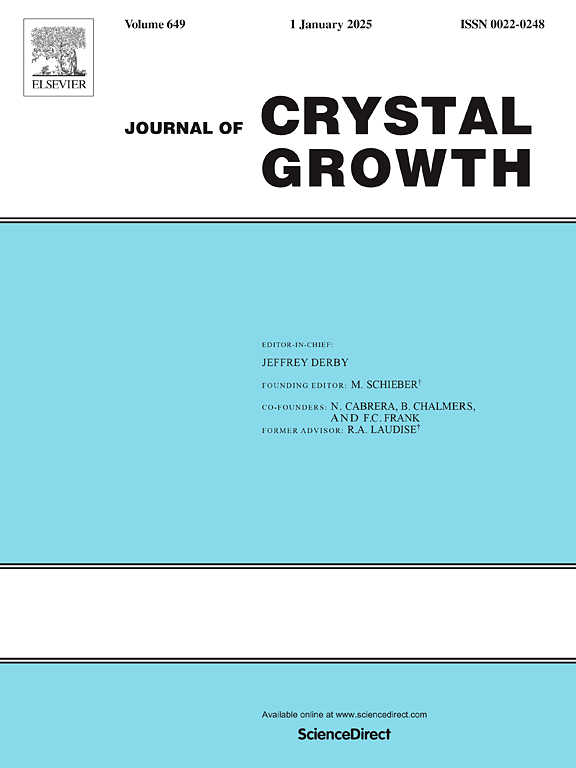Effects of magnetic intensity and crystal-crucible rotation direction on heat and oxygen transport during continuous Czochralski growth of an 8-inch diameter silicon crystal
IF 2
4区 材料科学
Q3 CRYSTALLOGRAPHY
引用次数: 0
Abstract
The effect of variations of temperature, flow, and oxygen distribution on the CCz growth of 8-inch diameter silicon crystals was numerically studied under a cusp magnetic field. As in the Cz growth process, the oxygen concentration at the crystal-melt interface is lower and more homogeneous when using the same rotation direction (iso-rotation) between the crystal and the crucible. In iso-rotation mode, the oxygen atoms released from the quartz wall are mainly transported to the inner free-melt surface by diffusion due to the weak melt speed in the inner melt. The strong outward flow of the melt beneath the growth interface caused by the fast crystal rotation may prevent oxygen diffusion into the ingot and is favorable for enhancing the evaporation of oxygen at the inner free-melt surface. The flow motion in the inner melt is much stronger in counter-rotation mode than in iso-rotation mode. This can alter the oxygen diffusion flux from the quartz wall to directly reach the growth interface. Therefore, the oxygen level along the crystal-melt interface will be higher than in the iso-rotation mode. When the magnetic intensity is high enough, the flow motion in the inner melt in the counter-rotation mode is significantly weakened, resulting in lower oxygen concentration at the growth interface. In iso-rotation mode, there is a significant increase in the effect of the outward melt flow beneath the growth interface as the magnetic field becomes stronger, which causes a notable decrease in the oxygen level.
磁性强度和晶体-坩埚旋转方向对8英寸直径硅晶体连续生长过程中热量和氧输运的影响
采用数值模拟方法研究了温度、流量和氧分布对8英寸直径硅晶体CCz生长的影响。与Cz生长过程一样,当晶体与坩埚采用相同的旋转方向(同向旋转)时,晶体-熔体界面处的氧浓度更低且更均匀。在等旋转模式下,由于内熔体的熔化速度较弱,从石英壁上释放出的氧原子主要通过扩散转移到内自由熔体表面。晶体快速旋转引起的生长界面下熔体强烈的向外流动可能阻止氧气向铸锭扩散,有利于加强内部自由熔体表面氧气的蒸发。在反旋转模式下,内熔体的流动运动要比在等旋转模式下强得多。这可以改变来自石英壁的氧扩散通量,使其直接到达生长界面。因此,沿晶体-熔体界面的氧水平将高于等旋转模式。当磁场强度足够大时,内熔体中反旋转模式的流动运动明显减弱,导致生长界面处氧浓度降低。在等旋转模式下,随着磁场的增强,生长界面下向外熔体流动的效果显著增强,导致氧含量显著降低。
本文章由计算机程序翻译,如有差异,请以英文原文为准。
求助全文
约1分钟内获得全文
求助全文
来源期刊

Journal of Crystal Growth
化学-晶体学
CiteScore
3.60
自引率
11.10%
发文量
373
审稿时长
65 days
期刊介绍:
The journal offers a common reference and publication source for workers engaged in research on the experimental and theoretical aspects of crystal growth and its applications, e.g. in devices. Experimental and theoretical contributions are published in the following fields: theory of nucleation and growth, molecular kinetics and transport phenomena, crystallization in viscous media such as polymers and glasses; crystal growth of metals, minerals, semiconductors, superconductors, magnetics, inorganic, organic and biological substances in bulk or as thin films; molecular beam epitaxy, chemical vapor deposition, growth of III-V and II-VI and other semiconductors; characterization of single crystals by physical and chemical methods; apparatus, instrumentation and techniques for crystal growth, and purification methods; multilayer heterostructures and their characterisation with an emphasis on crystal growth and epitaxial aspects of electronic materials. A special feature of the journal is the periodic inclusion of proceedings of symposia and conferences on relevant aspects of crystal growth.
 求助内容:
求助内容: 应助结果提醒方式:
应助结果提醒方式:


